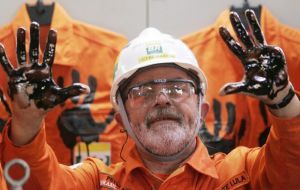MercoPress. South Atlantic News Agency
Petrobras begins deepwater pre-salt commercial crude production
 President Lula da Silva celebrates
President Lula da Silva celebrates Brazil’s government controlled energy giant Petrobras began commercial crude production Thursday from a deepwater deposit in the pre-salt region, which the government anticipates will turn the country into a global leader in oil production.
A ceremony was held on board the Capixaba floating production, storage and offloading vessel to mark the start of output from the well. President Lula da Silva was on hand and was photographed with his hands covered in oil extracted from the Baleia Franca field, located 85 kilometres offshore.
Lula da Silva held up a miniature oil barrel that he said “symbolizes the independence Brazil will have in the future”.
He also hailed Brazilian technology, which he said would ensure that a disaster along the lines of BP’s massive oil spill in the Gulf of Mexico does not occur in Brazil, according to a statement from his office.
A total of 13,000 barrels per day is to be drawn from Baleia Franca initially, although full capacity of 20,000 bpd is to be achieved by year’s end, Petrobras said in a press release.
The deposit was discovered in December 2008 and is located in the Campos basin, where 90% of Brazil’s current proven reserves are located.
Baleia Franca’s crude has an API, American Petroleum Institute, gravity of 29 degrees, which is considered to be medium or light oil and of high commercial value.
The company said in its statement that it used “state-of-the-art technology” developed specifically for extracting crude from deposits in the pre-salt frontier, so-named because the estimated 80 billion barrels of oil equivalent it may contain are located deep below the ocean floor under a layer of salt up to 2 kilometres thick.
Petrobras says that boring through that salt formation, due to its location and at high temperatures, requires that special care be taken with exploration equipment.
The Capixaba FPSO has operated since May and, once in full operation, will be connected to nine wells and produce up to 100,000 bpd.
If the most optimistic estimates prove correct, the pre-salt deposits, located in a 160,000-sq.-kilometre area, could translate into a nearly six-fold increase in Brazil’s current proven reserves of 14 billion barrels and transform the South American nation into a major oil power.
Petrobras began test production at the massive, ultra-deep Tupi field – the largest pre-salt deposit discovered to date, with an estimated 5-8 billion barrels of recoverable oil equivalent in May 2009.
Petrobras is Latin America’s second-largest oil company after Venezuela’s PDVSA and has a presence in more than two-dozen countries in the Americas, Africa, Asia, Europe and Oceania.




Top Comments
Disclaimer & comment rulesCommenting for this story is now closed.
If you have a Facebook account, become a fan and comment on our Facebook Page!